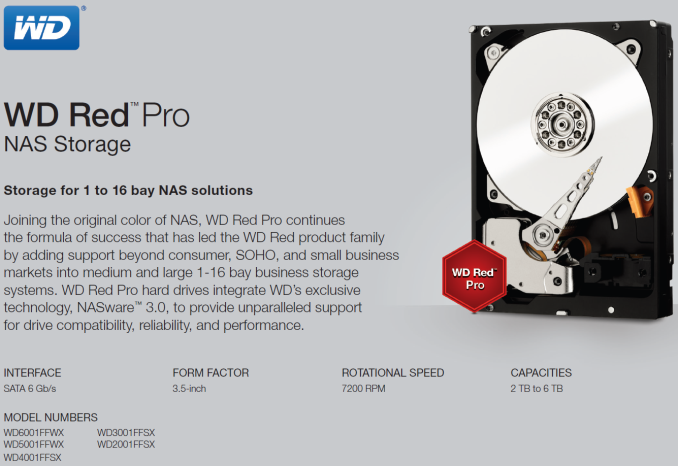WD Red Pro 6 TB Review - High Performance NAS HDD Gets a Capacity Bump
by Ganesh T S on September 7, 2015 8:00 AM EST- Posted in
- NAS
- Storage
- HDDs
- Western Digital
Concluding Remarks
The Western Digital Red Pro is the latest addition to our 6 TB drives evaluation set. We have taken a look at how it compares against the other 6 TB drives that have been evaluated before in both DAS and NAS scenarios. It is hard to recommend any particular 6 TB drive as the clear cut choice unless the particular application is known. The various hard drives in the comparison lot were launched targeting different markets and their resulting performance varies accordingly. At the most, the Seagate Enterprise NAS HDD and the WD Red Pro fall under the same category. However, they each win out on different workloads, with the Seagate drive enjoying a slight edge.
Thanks to the 7200 RPM speeds, the WD Red Pro does manage to acquit itself well in the overall performance category. Though it is not the absolute best, it performs admirably well in the sequential access patterns segment of the multi-client evaluation.
The WD Red Pro doesn't deliver the lowest power consumption. Those were recorded, as expected, with the 5400 RPM WD Red and the HelioSeal-technology based HGST Ultrastar He6. However, the WD Red Pro provides a good balance between speed and energy efficiency.
The WD Red Pro 6 TB version is priced at $300. At this price, users can also purchase the HGST Deskstar NAS 6 TB (though Newegg has reduced pricing for multiple disks in this case). The Seagate Enterprise NAS HDD comes in at $305, while the Enterprise Capacity v4 version comes in around $450. The choice at the $300 price point for 1-16 bay NAS units comes down to the WD Red Pro and the Seagate Enterprise NAS HDD. As mentioned earlier, the choice depends on the expected workloads.











62 Comments
View All Comments
DanNeely - Tuesday, September 8, 2015 - link
Except for upper end enterprise it's still probably too early to add 10gbe to a nas test suite.A few years back I remember reading that there was a process threshold that a lot of people were expecting to dramatically drive down the high power cost of sending a 10gb signal over twisted pair connections. Unfortunately I don't remember if it was 14nm; in which case we should start to see lower power hardware within a year or 10 nm; in which case we'll probably end up waiting until closer to 2020 before getting in in our boxes.
Hannibal80 - Wednesday, September 9, 2015 - link
Yes, that's absolutely true, my nas waste same power on the 10gbe adapter and on cpu and that's crazy. Still, with HD and then 4k videos, raw pics near or over 50MB each, old good hdd disks which continue to improve, 1gbe is going to be too limiting...2020 is really far away! ☺
Jaybus - Wednesday, September 9, 2015 - link
We could well see copper Ethernet being replaced by then. IBM just announced in May a 100 Gb/s transceiver using the first fully integrated wavelength multiplexed chip. The optical components are on-chip along side the electronic components. This integration is what will bring the price of optical Ethernet down to parity with copper. It will be a huge bump in bandwidth and power reduction. It is telling that the 100G consortium is already increasing the max distance to 1 km.Sivar - Tuesday, September 8, 2015 - link
I've been using the Western Digital's NAS with these drives, WD EX2100, since April. Very solid unit. Really easy to set up, and includes advanced features when needed such as link aggregation.lundgsi2@yahoo.co.uk - Tuesday, September 8, 2015 - link
thats great can't wait to get my hands on thesewww.hardwarecomputerstore.co.uk
ex_User - Wednesday, September 9, 2015 - link
I believe you have an error in specs. "Non-Recoverable Read Errors / Bits Read" for Red Pro is "<10 in 10^15", not 10^14.http://www.wdc.com/wdproducts/library/SpecSheet/EN...
asmian - Thursday, September 10, 2015 - link
No, they are right - 10 in 10^15 is exactly the same as 1 in 10^14. It's written/marketed that way to confuse and look much better than it really is.Using a less than sign doesn't really change the base order of magnitude - eg. 9 in 10^15 would be consistent with their PDF table claim and it is still almost 10 times worse than any enterprise drive at 1 in 10^15 URE, which is why non-enterprise are not worth buying at these fail-likely sizes if you value your data.
ex_User - Thursday, September 10, 2015 - link
Well, that misleading marketing works very well on laymen like me -- only after your post have I noticed the <1/<10 trick.leexgx - Saturday, September 12, 2015 - link
i agree that <1/<10 is Very misleading, so they have reduced or not added more error correction on these drivesleexgx - Saturday, September 12, 2015 - link
but if you getting unrecoverable read errors at that point you should replace the HDD as there is a problem with the drive, like i need to replace my segate {as the theme goes with seagate drives} as its slowly developing reallocated sectors, surprisingly its still working fine